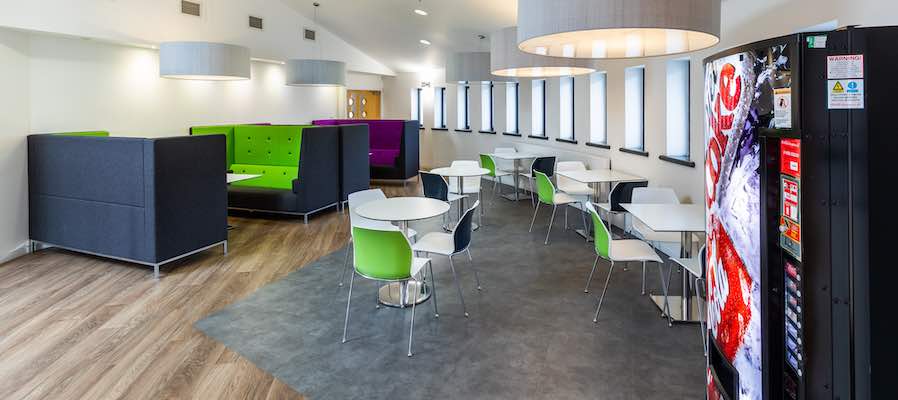Office Space Review and Predictions 2023/24 – Part Two
In Part One of this article we looked at the state of play in the office space sector, collating a range of statistics from 2023 and concentrating in particular on Scotland (and more specifically Aberdeen) to track how much of the impact of COVID-19 the sector had managed to make up and what effect changing trends in hybrid working had on the sector during the year.

In part two we’ll examine some more of the trends which emerged during the year, take a look at the collapse of WeWork and the lessons it might have for the retail office sector as a whole, and round up a few predictions of what we might be able to expect during 2024.
Serviced Office Sector
One sector which is still struggling to reach pre-pandemic levels of activity is the serviced office sector. Analysis published by Sirius Property Finance looked at not just the current state of the serviced office sector but also performance trends over the previous decade, to see whether past activity offered any clue as to future performance. What the figures show most clearly is that the sector enjoyed seven years of unbroken growth between the years 2013 and 2020. In 2013 the UK serviced office sector generated revenue of £961 million, but by 2020 this figure had hit a peak of £2.6 billion.
A large part of this growth was driven by the arrival of WeWork into the UK market in 2014, and an innovative approach to serviced office space which helped to drive something of a boom in the concept of co-working spaces. We’ll be looking at the fate of WeWork specifically later in this article, but the serviced office and co-working sector as a whole was hit particularly hard by the switch to working from home initiated in response to Covid-19. In 2021 the revenue from serviced offices dropped by 20.1%, followed by a further 21.8% in 2022, when revenue as a total peaked at £1.6 billion. The positive news, according to the Siruis figures, is that during 2023 the revenue for the sector is set to hit £1.9 billion by the end of the year, representing an annual growth rate of 16.8%. The chances of the sector hitting the heights seen pre-pandemic are doubtless pretty slim, but even a partial recovery is good news for those landlords able to operate successfully in a market which values quality over quantity.

The Future Of Flexible Workspace
The collapse of the aforementioned WeWork – in November 2023 the company filed for bankruptcy – offered both a cautionary tale for anyone tempted to adopt the complacent belief that current market conditions can be taken for granted in the longer term, and a number of lessons indicating what success in the flexible workspace market could look like in the future.
One fact which is clear is that the demand for Grade A buildings will continue to grow, with organisations keen not only on well-located buildings but also on those which offer the best facilities in terms of environmental, social, and corporate governance (ESG). In the simplest terms this means those spaces which have the best green credentials, and will enable anyone leasing space in them to flag up those green credentials to their customer base. Survey after survey has demonstrated the fact that modern consumers now factor in the sustainability of a business as part of their decision-making when considering spending with that business, and any landlord suffering from the shift away from co-working spaces could look to the sustainability of their office space as a means of making up for this loss.
As stated in the first article, new names are moving into the flexible workspace sector across the UK, which indicates that flexible working as whole is still a growth market even if the particular model pursued by WeWork turned out to be unsustainable. Nor is this growth restricted to the usual hot-spot of the West End of London, all too often used a yardstick by which to measure growth in the UK as a whole. One example of the nationwide nature of the growth is provided by the fact that Orega secured a 5k sq.ft expansion of the space it occupied in the Capitol Building in Aberdeen in July of this year. The expansion, up from an original investment of 10k sq. ft., was driven by high levels of demand for the existing flexible space.
The highest demand for space in the post-pandemic and now probably post-WeWork environment is almost bound to be for office space which combines Grade A location and amenities with the flexibility which organisations and the employees working for them now demand more than ever. Given the fact that any office space is now competing for utilisation with the option of working from home, the successful providers of the future are likely to be those who appreciate that a certain level of amenities could offer a point of difference for their spaces, with the likes of gyms and bars likely to help tempt employees (and the companies they work for) back into the office.

Office Space Predictions For 2024
Making predictions for a sector as varied and dynamic as office space is always going to be tricky, but it is possible – as we’ve hopefully already demonstrated – to look at current trends in the sector and the wider economy and extrapolate the impact which these trends might have in the future.
In broad economic terms, the UK is still firmly in the grip of a period of sluggish economic growth at best, and the use of higher interest rates to bring inflation under control meant that investment in the office sector, as in many other sectors, was limited during 2023. In total, the first three quarters of the year saw £6.5 billion invested in the UK office market, a figure expected to have risen by another £3.1 billion by the end of the year. This would still leave investment levels at their lowest for 20 years, and with the interest rate widely predicted to remain at around 5.25% for at least the first half of 2024, it probably won’t be until the second half of the year, when rates are expected to start shifting toward the 4.75% mark, that we should see investment activity in the UK market starting to pick up.
Quality And Flexibility In Demand
The result is likely to be overall investment in office space which is markedly up on 2023 but still low when compared to the 10 year average of £22 billion. The chilling effect which sustained high interest rates have had on investment in the office sector is also likely to be seen in the area of office-based employment, but rental growth is likely to be driven by, as previously noted, fierce competition for the very best office space needed to attract the highest calibre of employees in the hybrid working era. Across 2024 as a whole, the rental growth average in UK office markets is predicted to reach 3%, after strong growth during 2023.
In summary, the key prediction for the office space sector as a whole, and the Scottish part of that sector in particular, is that quality and flexibility will become more important than ever in 2024. Pre-Covid 19, working from an office, any office, was the norm across a wide range of sectors. The rise and sustained nature of the era of hybrid working, however, means that this is no longer the case – companies no longer need desk space for every worker on every day of the week, and office letting arrangements or office spaces which are based around this old way of thinking will struggle to attract renters. On a more positive note, those suppliers who are able to rise to the elevated expectations of organisations and their employees will find themselves in a position of being able to charge premium rents, as demand for quality outstrips supply.